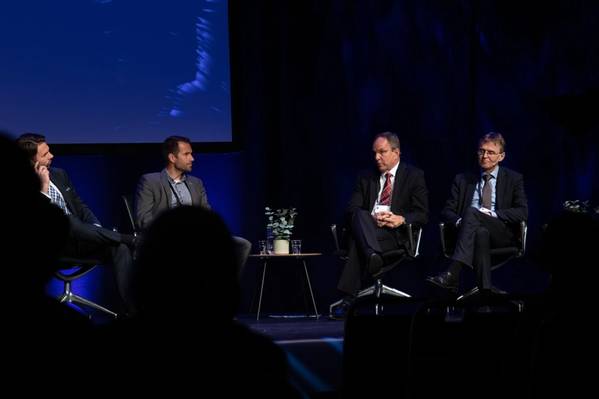
The light has been shone on the potential for the subsea oil and gas industry to not only play a role in but lead energy transition initiatives and new ocean industries in Norway and overseas during the Underwater Technology Conference (UTC) Bergen today.
Today’s event has touched on everything from carbon capture utilization and storage (CCUS) to and deep sea mining opportunities and hydrogen power storage twinned with floating offshore wind for everything from powering oil and gas facilities to remote islands or fish farms.
UTC Bergen, which wrapped up today, after two days of technical sessions, the Day 0 Market Insight Day, the conference dinner and awards, also focused on its traditional core: subsea technology.
This morning, students from Brazil and Norway presented on topics from performance tests of a new type of subsea actuator to alternative designs for subsea resident vehicles and analysing the effect of sand erosion on subsea chokes. In the technical sessions, talks ranged from NOV setting out how it’s been putting its subsea storage tanks through its paces at IFE, to Total talking about hydrate plug removal in ultra-deepwater.
New energies and emissions reducing initiatives also loomed large. Aker Solutions’ Zabia Elamin outlined work the company has been doing to assess the viability of using CO2 for enhanced oil recovery (EOR) in offshore fields. Fred Olsen focused on how to power them – with wave energy. Indeed, next year, the firm is due to work with Norwegian communications firm Tampnet to test putting a mobile 4G network in the sea, supported on a Fred Olsen floating wave energy device, UTC was told.
In the final plenary session, UTC then fully focused on initiatives toward transition, by using the technology, experience and competence in the subsea industry.
Aker Solutions’ Eirik Haugen outlined his company’s capabilities and ambitions towards floating offshore wind, as well as CCUS. “Through our history we have always been working through transitions,” he said. “Sustainable isn’t just reducing CO2 emissions, that’s incremental to a long-term sustainable vision. It’s a license to operate. This is a direction all of the industry needs to work in. Offshore wind is one of the solutions. Norway is blessed with a maritime history and wind conditions. We believe by using our competence in oil and gas we have extremely good prerequisites to succeed. I believe what Equinor doing with the Tampen project is showing this is a business case. It could be a big opportunity for the wind industry and could be a gap for us to move from oil and gas to offshore wind.”
TechnipFMC’s Andreas Løvli outlined his company’s work on “Deep Purple” technology. This is a way to stabilize offshore wind power by using a large scale hydrogen storage for handling the seasonal variations in the wind. “Gas turbines on the NCS emit equivalent to a quarter of total emissions in Norway,” he said. Using wind to power offshore facilities and then using excess power to create hydrogen, which is then stored subsea and then used in hydrogen fuel cells when it’s needed, could eliminate those emissions, he said. “We believe this concept will be competitive and the cost of offshore wind is coming down quickly. We are now working to establish a pilot of the concept, that would supply a remote island offshore Norway with renewable and stable power.”
Egil Tjåland, from NTNU, said that the experience generated by the oil and gas industry over the last 50 years could help forge a new minerals mining industry in Norway. It’s timely. On July 1, a new law will be enacted on mineral mining activity on the NCS.
“Deep sea mining is a possible new bonanza for the offshore industry,” he says. “The law is coming. The Norwegian Ministry of Petroleum and Energy has responsibility for managing mineral deposits on the shelf. But the resources will need to be explored and mapped before any exploitation licenses are given.
“Research organizations and universities have been doing cruises mapping crust and the black and white smokers, pouring up metallic plumes form the sea bottom. The technologies used have mostly been ROVs, equipment largely developed for use in the oil industry. As we know for conventional mining, there’s a huge focus on environmental risks. But there must also be an economic benefit to do this.
“At NTNU, we’ve started a research program to address these issues. We have more than 20 PhDs and post docs doing studies from exploration, resource exploitation, ethics, and economy.
The oil and gas industry could even help space exploration, said Oceaneering’s Bloomfield, who used to command NASA’s space shuttle. He said there’s an ambition to de-man these facilities, sending fewer humans into space. To do that, they need more remote control capabilities and in this area the subsea industry could help space exploration. “I see us transferring remote control operations from the subsea industry to Nasa in what we do going forward,” he said.
For Owe Hagesæther, CEO at GCE Ocean Technology, co-organizer of UTC Bergen, there are many opportunities and plenty more space to run. Indeed: “Subsea is Norway’s space mission,” he said.